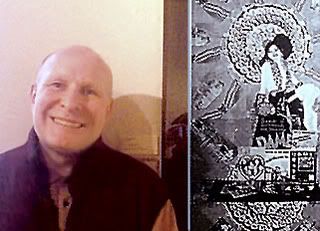
Visit: Michael's Montana Web Archive
Theater, Art, Flash Gordon, Funky Music and MORE!
Weather: Indian Summer is pretty gray today -- we've had a few drops of rain, and it was a warm night because of the low clouds.
Charity Alert: The Hunger Site Clicking helps feed people.
Media Watch: PBS' American Masters -- Part 2 of Martin Scorsese's Bob Dylan film, No Direction Home. It picks up the story in 1964 and finishes in 1966, at the end of his European tour -- when he had the motorcycle accident which marked the beginning of a long isolation. The film mentions that he continued to write songs, but didn't tour for eight years. I could see why -- it was literally insane the way he and his band suffered all the normal road travails just to be shouted at and booed by ignorant adolescents and post-adolescents while trying to keep their bearings in a media world that alternately worshipped Dylan as a diety or cursed him like a devil.
Remember my remark yesterday about our rapidly-mutating society? It was in hyper-flux during that time, and would even get wackier. I didn't understand it at the time, but Dylan's withdrawl from the public was absolutely necessary to save whatever sanity he still possessed in the wake of the "Folk Rock Revolution," which dogged his ass after his own popular success. This film gives the viewer a glimpse of the pressures he faced, and his interviews show the inhuman strain he endured.
All that being said, what generated the aforementioned phenomena was the number and quality of Bob Dylan's songs. In the film, Columbia Records' laid-back country music producer Bob Johnson said words to the effect that Dylan was touched, or rather grabbed and shaken, by God in those days -- in respect to creating music.
As a young fan back then, I will attest to my astonishment in hearing one great song after another from this person's pen. Bringing It All Back Home was one of the very first albums I bought with my summer job money. Like A Rolling Stone was something nobody had ever heard before on the radio, and his Highway 61 Revisited album was unsurpassed for raw creative energy for many more years. Each one of his "old" albums were loaded with treasures too. In August of 1965 he set a record that will probably never be matched again -- seventeen songs of his, performed by himself and others, were listed in Billboard's Hot 100. What further knocked me out was the way his prolific streak continued on 1966's double-disc Blonde On Blonde.
At the time of his motorcycle accident his musical accomplishments were comparable not only to Leadbelly or Woody Guthrie, but also to Cole Porter, Rogers & Hart & Hammerstein, and you-name-whatever popular composer. His recent autobiography tells how he spent his time with his wife and growing family afterwards, but the great songs also kept coming too. That cryptic note at the end of Part 2 was an understatement. Several big books could be written about Dylan's influence on music and culture, but I ain't gonna write 'em, and I'm sure he ain't gonna read 'em either.
His records varied in quality afterwards, for sure -- his book tells how he tried to distance himself from the myths about himself this way, but there was still more fabulous unheard music in his vaults. Whomever sneaked the pirated Great White Wonder tapes out of upstate New York did the world a favor -- but I think it made Dylan angry -- so angry that he released trash like Self Portrait and Dylan. (The former has one or two good cuts, though.)
I was so happy when I finally heard albums like New Morning and Blood On The Tracks. I could do without Planet Waves or careless live recordings, but time continues to justify my hopes over the long decades when his awesome powers come back into focus. He claims that he doesn't write the way he used to write, and something tells me he's happy about that!

No comments:
Post a Comment